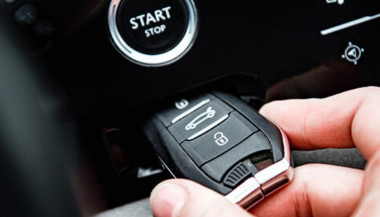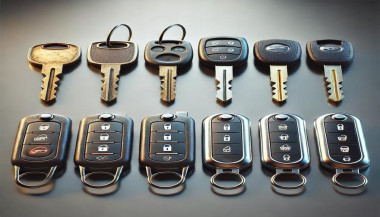Modern car keys have come a long way from the traditional cut metal blades of the past. What was once a simple tool for turning an ignition has evolved into a smart, encrypted device with layers of built-in security. Among the most critical components in today’s car keys is the transponder chip — a small but vital element that could be the reason your car doesn’t start after replacing your key shell.
If you've recently changed the shell or casing of your key and suddenly find that your car won’t start, you're not alone. This is one of the most common (and frustrating) issues car owners face when performing a key repair or upgrade. So let’s break down what’s really happening — and how you can fix it.
What Is a Transponder and What Does It Do?
A transponder chip (short for “transmitter-responder”) is a small electronic component embedded in your car key. Its purpose is to communicate with your vehicle’s immobilizer system to authorize ignition.
Here’s how it works:
When you insert your key and turn the ignition, your car sends out a radio signal.
The transponder chip in your key responds with a coded signal unique to your car.
If the code is correct, the car’s computer disables the immobilizer and allows the engine to start.
If the chip is missing, broken, or the code doesn’t match — the engine won’t start, even if the key blade physically turns.
This system is an anti-theft measure, and it's present in most vehicles manufactured after the late 1990s. Without a functional transponder, your key may unlock the doors but it will not allow the car to start. This ensures that even if someone manages to copy the physical blade of your key, they still can’t steal your car.
Why Your Key Might Not Work After Shell Replacement
Changing your key shell (also called a case or housing) can seem like a simple cosmetic repair — but it’s easy to overlook the importance of transferring the transponder chip during the process.
If your key no longer starts the car after a shell replacement, the most likely reason is:
You forgot to move the transponder chip into the new shell.
In many keys, the chip is not part of the electronics board. It’s often a tiny black or glass capsule, sometimes hidden in a small compartment within the key shell — completely separate from the buttons and battery. If you didn’t see it, it’s probably still sitting inside the old casing.
Some people assume that simply moving over the circuit board and battery is enough — but without the transponder, your key won’t be recognized by the car’s immobilizer. This results in the engine failing to start, even though the buttons may still lock and unlock the doors.
Symptoms of a Missing or Misplaced Transponder
If your key turns in the ignition but:
The car does not crank or start
You see a flashing key icon or immobilizer warning on the dashboard
The central locking might still work, but the engine won’t respond
You hear a clicking sound but no ignition occurs
Then it’s almost certainly a transponder issue. The car's system is waiting for a valid coded signal from the key — and without it, the start command is rejected.
How to Fix It: What You Need to Do
Here’s how to get your car running again:
1. Check Your Old Key Shell
Open the old casing and look for a small black or clear capsule (typically rice-sized). That’s your transponder chip. Some are glued in place and may require careful prying.
2. Transfer the Chip
Carefully remove it and insert it into the correct compartment in your new key shell. Some aftermarket shells have a specific slot for it, while others require a bit of creativity to keep it securely in place. In some cases, adhesive putty or double-sided tape can help hold it.
3. Reassemble and Test
Put your key back together and try starting the car again. If the chip is correctly placed, it should work immediately — no reprogramming needed. Always test both ignition and door lock/unlock functions.
What If You Lost the Chip?
Unfortunately, if the chip is damaged or lost, the key will no longer be able to start your vehicle. In this case, you’ll need to:
Contact a professional auto locksmith
Have a new transponder chip programmed to your car’s immobilizer system
Provide proof of ownership (such as your vehicle logbook or registration) in most cases
Depending on the make and model of your car, programming a new chip may cost anywhere from $50 to $250, and it typically requires special diagnostic equipment.
It’s worth noting that some dealerships may charge significantly more than independent auto locksmiths — and you may have to wait longer for service.
Pro Tips When Replacing Your Key Shell
Always examine the inside of your old shell carefully before throwing it away.
Take photos before disassembly so you know where each component goes.
If you're unsure where the chip is or how to transfer it, look for DIY videos specific to your key model.
Use tweezers and caution — the chip is fragile.
Avoid static electricity or contact with magnets during the transfer process.
Some modern keys have transponders integrated into the circuit board, in which case no separate chip needs to be moved.
If you’re working with a smart key or proximity key, additional steps may be required. These typically involve re-synchronization with the vehicle’s system and may not function correctly without professional assistance.
Small Chip, Big Consequences
It’s incredible how something as small as a transponder chip can control such a major function. Replacing your key shell is a great way to refresh the look and feel of your key — but it’s vital not to overlook the importance of transferring every component, especially the transponder.
Many DIY repairs are abandoned or lead to confusion simply because of this overlooked step. Fortunately, it’s one of the easiest problems to fix once you understand what to look for.
If your key looks brand new but your car won’t start, don’t panic. Chances are, the solution is sitting inside your old key shell — quietly waiting to be moved over.

 (1)_1743078116.jpg)
 (1)_1736344659.jpg)
 (1)_1741183083.jpg)

